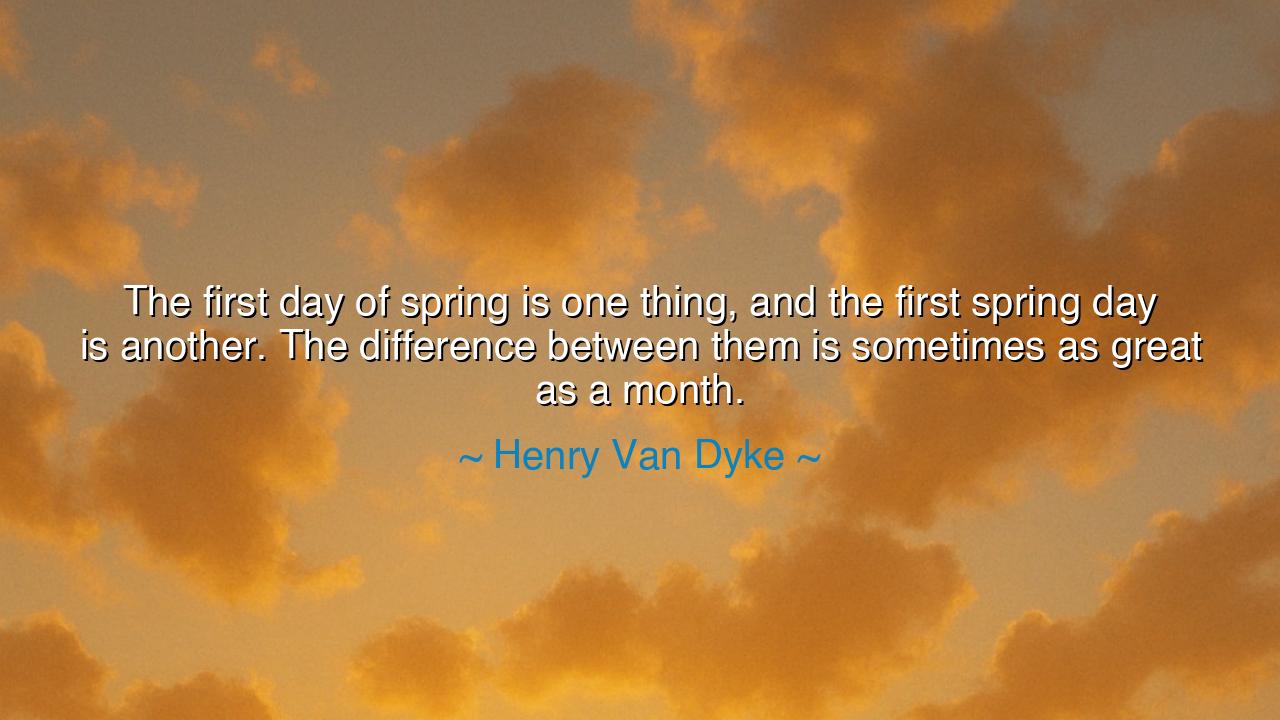
The first day of spring is one thing, and the first spring day is
The first day of spring is one thing, and the first spring day is another. The difference between them is sometimes as great as a month.






“The first day of spring is one thing, and the first spring day is another. The difference between them is sometimes as great as a month.” Thus wrote Henry Van Dyke, the American poet, clergyman, and philosopher of the gentle spirit, who sought to find divine wisdom in the rhythm of nature. In these simple yet profound words, he speaks not merely of seasons and weather, but of patience, transformation, and the living truth that time cannot be rushed. The saying, though born from the observation of the earth’s slow awakening, carries the eternal wisdom that the soul, like the world, blossoms not by decree, but by ripening.
Van Dyke lived at the dawn of the twentieth century, a man attuned to the harmony of faith, nature, and art. He observed the cycles of the natural world not only as a minister of the spirit but as a poet of the heart. The “first day of spring”, he noted, is a calendar promise — a declaration that the world has turned toward warmth. Yet the “first spring day” — that moment when the air softens, when the earth truly breathes again, and the scent of life returns — arrives not by man’s reckoning, but in its own time. Between the two lies the distance between expectation and fulfillment, between what is written and what is real.
In this difference, Van Dyke saw a mirror of the human condition. For how often do we, too, declare the beginning of new seasons in our lives — the end of sorrow, the dawn of hope — and yet find that the heart remains frozen, waiting for its true thaw? We mark our calendars with resolutions, new beginnings, and promises of change, but nature teaches us that transformation is not bound to dates or declarations. Growth is quiet, unseen, and often slow; the sap rises before the leaves appear, and the roots awaken before the flowers bloom. To live in harmony with life is to accept that the real spring — whether in the soul or in the soil — comes when it is ready, not when we command it.
This wisdom is reflected in the story of Abraham Lincoln, who endured many winters of hardship before his true “spring day” arrived. He lost elections, faced poverty, and suffered deep personal grief, yet he continued to labor, often without visible reward. Though the “first day” of his hope may have dawned early in his youth, the true spring of his destiny — the presidency, and the fulfillment of his purpose — came much later, after years of preparation and trial. Like the earth that must rest beneath snow before it can bear fruit, Lincoln’s spirit ripened slowly. Van Dyke’s words remind us that greatness, like spring, must arrive in its own season.
In nature, the gap between the calendar’s spring and the felt spring is filled with endurance. The winds still bite; the frost still lingers. Yet beneath the ground, unseen by the eye, life is stirring. So it is with the heart: even when all seems cold, something holy is working in silence. Every struggle, every delay, is part of the awakening. The month of waiting between promise and fulfillment is the sacred season of faith. Only those who endure this interval with patience can truly taste the sweetness of the first warm day when it finally comes.
Van Dyke’s teaching, though clothed in the language of seasons, is a call to trust the process of becoming. In a world that craves instant change, his words remind us that time is the servant of purpose, not its master. Do not despair if your spring seems slow in coming; even the longest winter cannot hold back the sun forever. Learn to live in anticipation without frustration, to labor quietly while waiting for warmth. For when the true spring day comes, it will come suddenly — and it will be glorious.
Therefore, O seeker of wisdom, take this lesson to heart: do not mistake the announcement of change for the arrival of transformation. The first day of spring is but a promise; the first spring day is the promise fulfilled. Between the two lies the sacred space where patience, faith, and preparation dwell. Work faithfully in that in-between season, for life ripens unseen, and every frost that lingers is shaping the bloom to come.
So, let Van Dyke’s words be your compass: the world does not hurry its miracles, nor should you. The spring of your life — the moment of warmth, renewal, and fulfillment — will arrive when both the earth and your spirit are ready to receive it. Until then, wait with peace, labor with love, and believe — for though the calendar may promise the season, the heart must feel it before it is truly spring.






AAdministratorAdministrator
Welcome, honored guests. Please leave a comment, we will respond soon